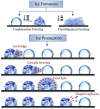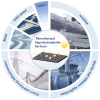Research Progress of Photothermal Superhydrophobic Surfaces for Anti-Icing/Deicing
- PMID: 40363672
- PMCID: PMC12073101
- DOI: 10.3390/molecules30091865
Research Progress of Photothermal Superhydrophobic Surfaces for Anti-Icing/Deicing
Abstract
Photothermal superhydrophobic surfaces with micro/nano-structured morphologies have emerged as promising candidates for anti-icing and deicing applications due to their exceptional water repellency and efficient solar-to-thermal conversion. These surfaces synergistically integrate the passive icephobicity of superhydrophobic coatings with the active heating capability of photothermal materials, offering energy-efficient and environmentally friendly solutions for sectors such as aviation, wind energy, and transportation. Hence, they have received widespread attention in recent years. This review provides a comprehensive overview of recent advances in photothermal superhydrophobic coatings, focusing on their anti-icing/deicing mechanisms, surface wettability, and photothermal conversion performance for anti-icing/deicing applications. Special emphasis is placed on material categories, including metals and their compounds, carbon-based materials, and polymers, analyzing their structural features and application effectiveness. Furthermore, the application of anti-icing/deicing in various fields is described. Finally, perspectives on future development are presented, including pursuing fluorine-free, cost-effective, and multifunctional coatings to meet the growing demand for innovative, sustainable anti-icing/deicing technologies.
Keywords: advanced coatings; anti-icing/deicing; applications; photothermal; superhydrophobic surfaces.
Conflict of interest statement
The authors declare that they have no known competing financial interests or personal relationships that could have appeared to influence the work reported in this paper.
Figures















References
-
- Cao Y.-H., Wu Z., Su Y., Xu Z. Aircraft flight characteristics in icing conditions. Prog. Aerosp. Sci. 2015;74:62–80. doi: 10.1016/j.paerosci.2014.12.001. - DOI
-
- Mortimer A.R. A review of the icing problem for aerogenerators. Wind Eng. 1980;4:183–191.
-
- Rekuviene R., Saeidiharzand S., Mažeika L., Samaitis V., Jankauskas A., Sadaghiani A.K., Gharib G., Muganlı Z., Koşar A. A review on passive and active anti-icing and de-icing technologies. Appl. Therm. Eng. 2024;236:123474. doi: 10.1016/j.applthermaleng.2024.123474. - DOI
-
- Hudecz A. Ph. D. Thesis. Technical University of Denmark; Kongens Lyngby, Denmark: 2014. Icing Problems of Wind Turbine Blades in Cold Climates.
-
- Fortin G., Perron J. Wind turbine icing and de-icing; Proceedings of the 47th AIAA Aerospace Sciences Meeting Including the New Horizons Forum and Aerospace Exposition; Orlando, FL, USA. 5–8 January 2009.
Publication types
LinkOut - more resources
Full Text Sources

